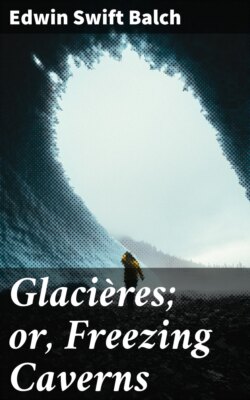Glacières; or, Freezing Caverns

Реклама. ООО «ЛитРес», ИНН: 7719571260.
Оглавление
Edwin Swift Balch. Glacières; or, Freezing Caverns
Glacières; or, Freezing Caverns
Table of Contents
PART I
PART II
THE CAUSES OF SUBTERRANEAN ICE
I
II
III
PART III
PART IV
PART V
INDEX
Отрывок из книги
Edwin Swift Balch
Published by Good Press, 2021
.....
The entrance to Dóbsina faces nearly due north. It is small, perhaps two meters wide and three meters high, and is perfectly sheltered from any wind. The sudden drop in temperature at the entrance was startling; in fact it was the most extreme change I have noticed in any cave. Within the length of an ordinary room, say in a distance of five meters, we passed from an extremely hot summer morning to the chill of a mid-winter afternoon. A slight air current, perhaps, issued from the entrance, as we observed a faint mist there. At the rock portal there was ice on the rocks overhead, and underfoot was the beginning of the huge mass of ice which almost fills the cavern. A descent down eighteen wooden steps landed us at the beginning of a great ice floor, in what is called the Grosser Saal. It is a magnificent cave. The floor is a sheet or rather a mass of solid ice, the surface of which is level enough in one place to permit of skating; in other spots it is sloping and covered with small ice hillocks. The ice is solid throughout, without any holes or cracks. Several fissure columns stream to the floor from cracks in the sides. Joining the roof to the floor are numerous big ice stalactites, which form frozen pillars and columns. These are from eight to eleven meters in height, and some two to three meters in average breadth and width. Nearly translucent, they are covered with all sorts of icy ornaments hanging about them in tufts and fringes; they are beautiful in their shapes, as well as in their white and blue colors. One of these columns is called the Brunnen, because until about ten years ago, a small stream dribbled continuously from the roof and cut a channel across the ice floor; but now the stream has solidified into the pillar, and the channel is filled up, although it can still be traced in the ice.
The ice extended to the sides of the cave except in two places. Here there were holes in the ice, bridged by low rock arches. We passed through one of these and descended by a wooden staircase some eighty steps, afterwards returning up through the other arch by another staircase. At the bottom we stood in a magnificent gallery named the Korridor, formed by a solid wall of ice on one side and by a wall of limestone rock on the other. The ice wall is the lower portion of the ice floor; the rock wall is the continuation of the roof. For the entire distance the ice wall rises almost perpendicularly some fifteen meters in height, while the rock wall arches overhead.
.....